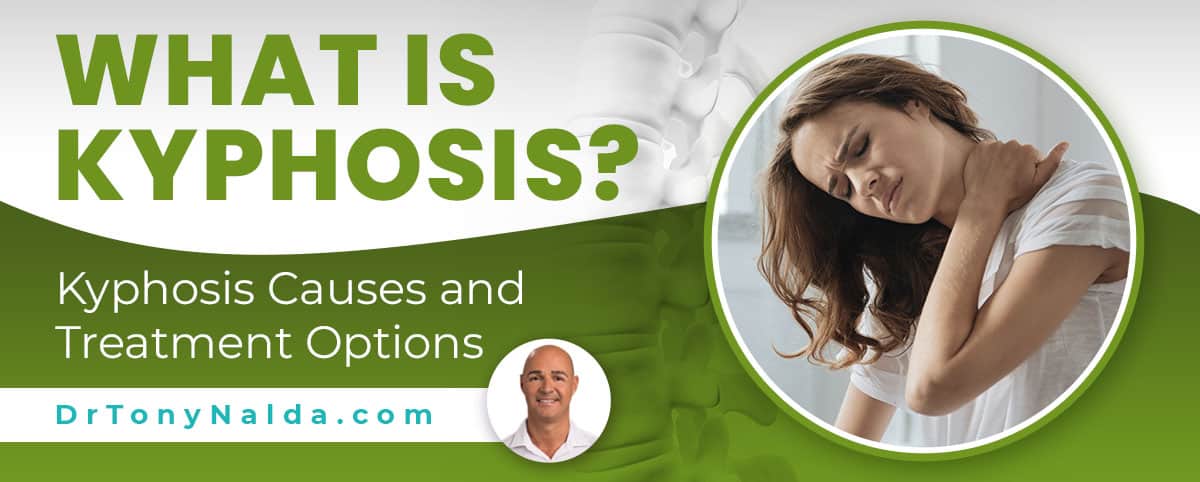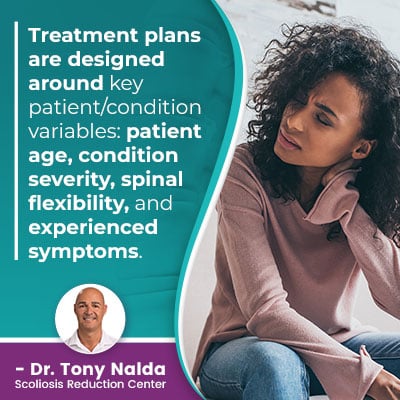What Is Kyphosis? Kyphosis Causes and Treatment Options

There are a number of spinal conditions and issues a person can develop that involve a loss of its healthy curves and misaligned vertebrae, kyphosis being one of them. There are three main spinal sections, each with its own characteristic curvature type. Continue reading to learn more about kyphosis, including causes and treatment options.
The spine’s health and function are largely determined by its natural curves and alignment; kyphosis refers to an outward spinal curve that bends away from the body’s center. If a person’s kyphosis becomes excessive, it’s also known as hyperkyphosis and can give posture a pitched-forward appearance.
Let’s start our kyphosis discussion by explaining the difference between healthy and unhealthy spinal curves.
A Healthy Spine
A healthy spine’s natural curves make it stronger, more flexible, and better able to absorb and distribute mechanical stress incurred during movement, much like a coiled spring works.
When the spine is able to maintain its natural and healthy curves, its alignment is also preserved; vertebrae (bones of the spine) are stacked on top of one another in a straight and neutral alignment.
If an unhealthy curve develops, the spine is no longer in alignment, disrupting the entire spine's biomechanics. In addition, each spinal curve's health depends upon the others' health.
There are three main spinal sections: cervical (neck), thoracic (middle/upper back), and lumbar (lower back).
When viewed from the front or back, the spine will appear straight, and when viewed from the sides, it will take on a soft ‘S’ shape, and this is due to the two main spinal-curve types: kyphosis and lordosis.
Kyphosis and Lordosis
Even within a healthy spine, a person’s degrees of curvature will vary, and as long as a spinal curve falls within a healthy range, spinal health and function are preserved, but if a curve falls beyond a normal range, becoming excessive, this is when problems occur.
There are two main types of curvatures: kyphosis and lordosis.
Kyphosis refers to the spine’s outward curvature that bends away from the body’s center in a reverse ‘C’ shape, while the term lordosis refers to the spine’s inward curves that bend towards the body’s center in a standard ‘C’ shape.
As mentioned, each spinal section has its own unique curvature type and range of curvature degrees.
Kyphosis is found in the thoracic spine, and a healthy range of kyphosis would fall between 20 and 40 degrees, and lordosis is found in the cervical and lumbar spinal sections with a healthy range of cervical lordosis falling between 20 and 40 degrees. A normal range of lumbar lordosis falls within a 20-to-40-degree range.
What is Kyphosis?
 If a person’s thoracic kyphosis becomes over-pronounced, the middle/upper back curve is excessive, and this also affects the health of the other spinal sections and curves.
If a person’s thoracic kyphosis becomes over-pronounced, the middle/upper back curve is excessive, and this also affects the health of the other spinal sections and curves.
While this can be somewhat confusing, particularly within the medical world, the term kyphosis is used in reference to both a healthy and unhealthy level of kyphosis, while hyperkyphosis refers solely to unhealthy excessive kyphosis.
In most cases, hyperkyphosis is diagnosed with kyphotic curves of 50+ degrees.
So now that we’ve defined the condition by exploring the difference between healthy and unhealthy spinal curves, let’s address the different types of kyphosis, as each has its own causation and treatment needs.
Postural Kyphosis
Postural kyphosis is not only the most common form, but it is also the simplest to treat, and that’s because it’s not a structural condition (caused by a structural abnormality within the spine itself).
Symptoms of postural kyphosis can include an excessively rounded-forward upper back and will likely involve some level of muscle or back pain, although more commonly painful in adults.
Postural kyphosis is caused by chronic poor posture and slouching that, over time, and particularly during growth, can excessively stretch the ligaments and muscles that surround and support the spine.
When the ligaments and muscles surrounding the spine are stretched, they can disrupt the positioning of nearby vertebrae, causing the excessive round-back appearance associated with hyperkyphosis.
As postural kyphosis is nonstructural, this means the position of the spine can be adjusted with changes in position and posture; an unnatural postural kyphotic curve will decrease when an active effort is made to stand up straight with the shoulders back.
While postural kyphosis can develop at any age, it’s most prevalent among adolescents.
Treatment for postural kyphosis often involves physical therapy to encourage postural remodeling and re-learning how to hold the body in a healthy position and increase core strength so the spine is optimally supported by its surrounding muscles.
Scheuermann’s Kyphosis
Scheuermann’s kyphosis is structural, so it is more complex to treat than postural kyphosis, as no change in position will change the structure of the spine itself when malformed vertebrae are involved.
A diagnosis of Scheuermann’s kyphosis means the thoracic spine has kyphosis of 50+ degrees, at least three adjacent vertebrae that feature a 5-degree wedge per vertebral body, and small disc herniations known as Schmorl’s nodes .
Because Scheuermann’s is structural, symptoms tend to be more severe, and the condition is most commonly detected during adolescence.
Symptoms can include a round back appearance, fatigue, pain in the thoracic spine, and a rigid curve that doesn’t correct with changes to position.
Scheuermann’s kyphosis is caused by a structural abnormality within the spine itself, which can involve the fronts of the vertebrae not forming as quickly as the backs, or being more triangular in shape, than healthy rectangular-shaped vertebrae.
When vertebrae are more triangular, they form wedges that shift affected vertebrae forward, as they are not aligned with the rest of the spine, and develop into an unnatural outward spinal curve.
 There is thought to be a familial component to Scheuermann’s, and it’s been suggested that causation is also related to height and weight.
There is thought to be a familial component to Scheuermann’s, and it’s been suggested that causation is also related to height and weight.
Treatment plans are designed around key patient/condition variables: patient age, condition severity, spinal flexibility, and experienced symptoms.
The reality is that most cases of Scheuermann’s can be treated non-surgically, and here at the Scoliosis Reduction Center, I specialize in non-surgical treatment for a variety of spinal conditions, kyphosis included.
A conservative chiropractic-centered treatment approach involves manually adjusting the position of the most-tilted vertebrae back into alignment with the rest of the spine, and a variety of condition-specific exercises and therapies can help increase core strength so the spine’s surrounding muscles and ligaments can support and stabilize the spine.
Corrective bracing can also be an effective means of augmenting corrective results achieved through other treatment disciplines, particularly in young patients, by pushing the spine into a corrective position.
Congenital Kyphosis
In cases of congenital kyphosis, infants develop the condition in utero due to malformed vertebrae, and infants and children with congenital kyphosis are more likely to have additional defects in other bodily systems also related to malformation.
Symptoms can range widely based on condition severity, from subtle to overt, which is why congenital kyphosis so often goes undiagnosed until a child starts to move around on their own.
When noticeable, the excessively-rounded middle/upper spine can look like a lump in the back.
In a healthy spine, vertebrae are rectangular in shape and stacked on top of one another in a straight and neutral alignment, and the vertebrae are connected by cartilage: an elastic tissue.
With congenital kyphosis, the front edges of one or more of the thoracic spine’s vertebrae don’t develop as they should and are more wedge-shaped than rectangular, as they should be, which shifts the spine forward; hence the development of a forward-rounding spinal curve.
In some severe cases, and because growth is a trigger for progression, congenital kyphosis is treated surgically; non-surgical treatment for congenital kyphosis would involve a combination of careful observation and monitoring, chiropractic care, core-strengthening, and corrective bracing (once a child is old enough).
Conclusion
So what is kyphosis? The term kyphosis refers to the spine’s outward curvature that bends away from the body’s center and can be used interchangeably with the term hyperkyphosis, used in reference to excessive kyphosis.
While everyone has their own unique degree of spinal curves, there is a normal and healthy range, and if a person’s kyphosis is 50+ degrees, this is excessive enough to cause problems.
In addition, there are different types of kyphosis, the most common being postural, Scheuermann’s, and congenital, with postural being the simplest to treat because it’s nonstructural, and Scheuermann’s and congenital kyphosis needing treatment to impact the condition, first and foremost, on a structural level.
The best time to start kyphosis treatment is always now, particularly in young patients, as progression is triggered by growth and development and to prevent further damage to the spine and its surrounding ligaments, muscles, and nerves.
The most noticeable symptom of hyperkyphosis is a round back appearance as posture is disrupted, so if you’ve noticed what appears to be an excessively-rounded forward upper back, this can indicate the need for further testing so a diagnosis can be reached and proactive treatment can be started.
Dr. Tony Nalda
DOCTOR OF CHIROPRACTIC
After receiving an undergraduate degree in psychology and his Doctorate of Chiropractic from Life University, Dr. Nalda settled in Celebration, Florida and proceeded to build one of Central Florida’s most successful chiropractic clinics.
His experience with patients suffering from scoliosis, and the confusion and frustration they faced, led him to seek a specialty in scoliosis care. In 2006 he completed his Intensive Care Certification from CLEAR Institute, a leading scoliosis educational and certification center.
About Dr. Tony Nalda
 Ready to explore scoliosis treatment? Contact Us Now
Ready to explore scoliosis treatment? Contact Us Now





